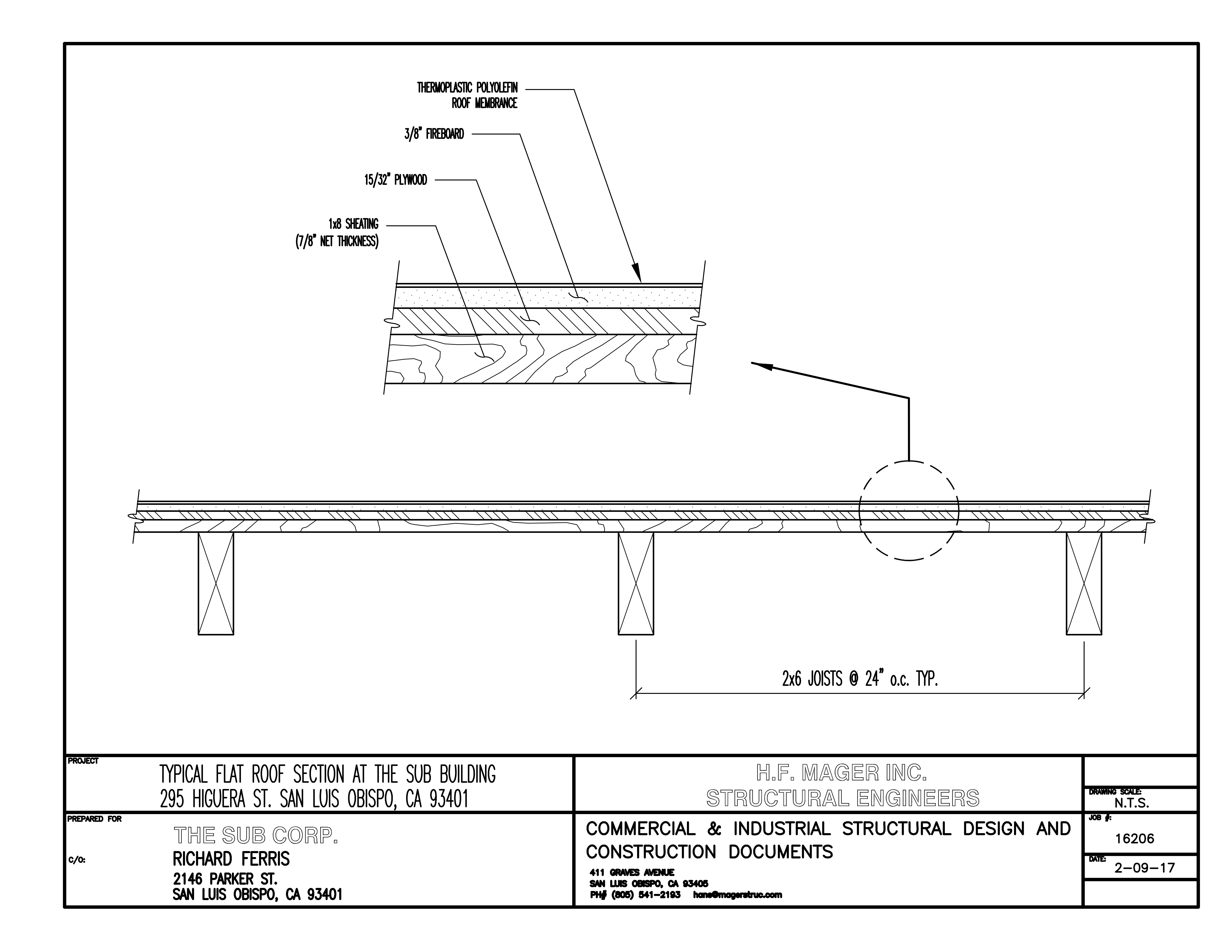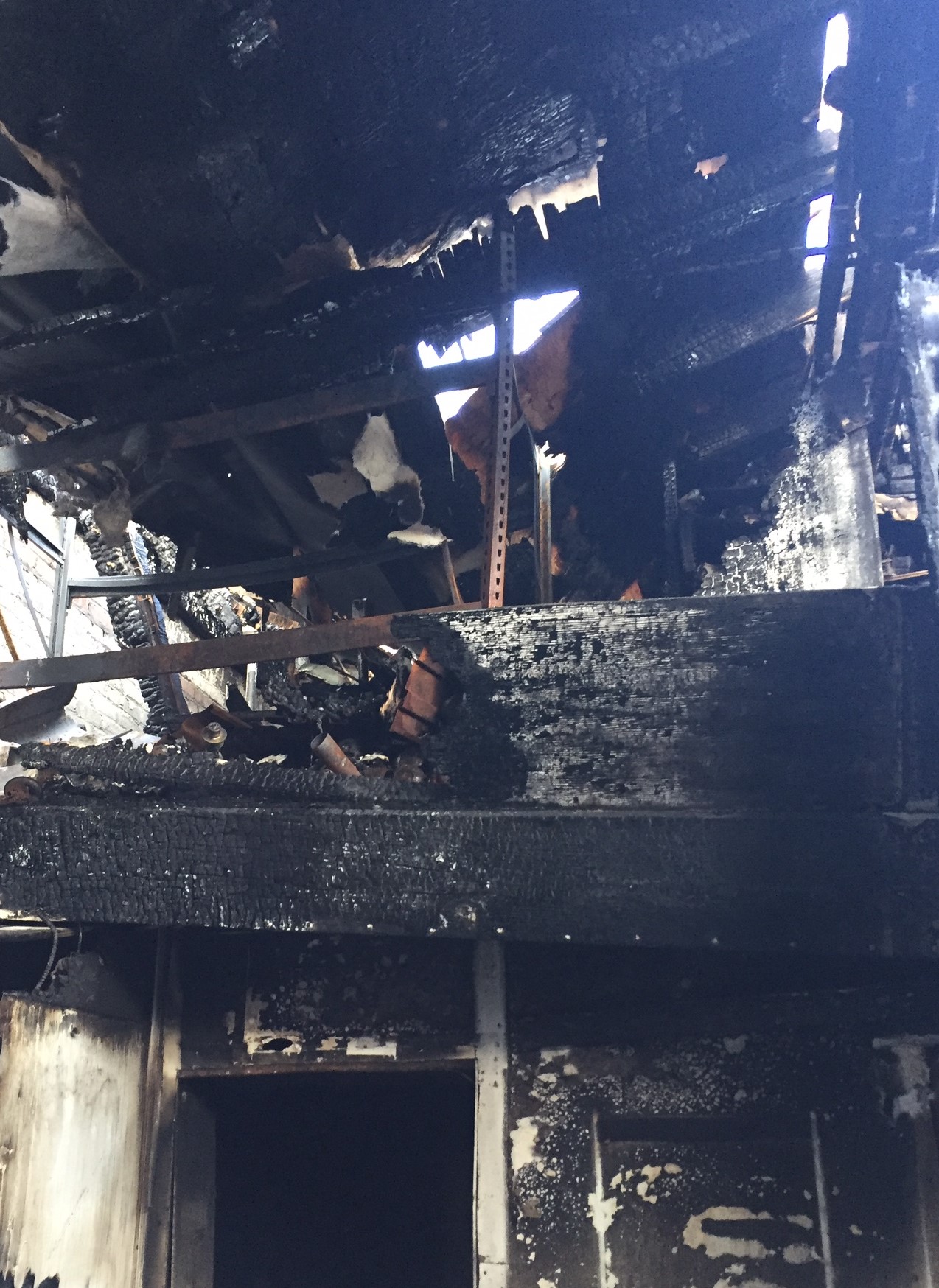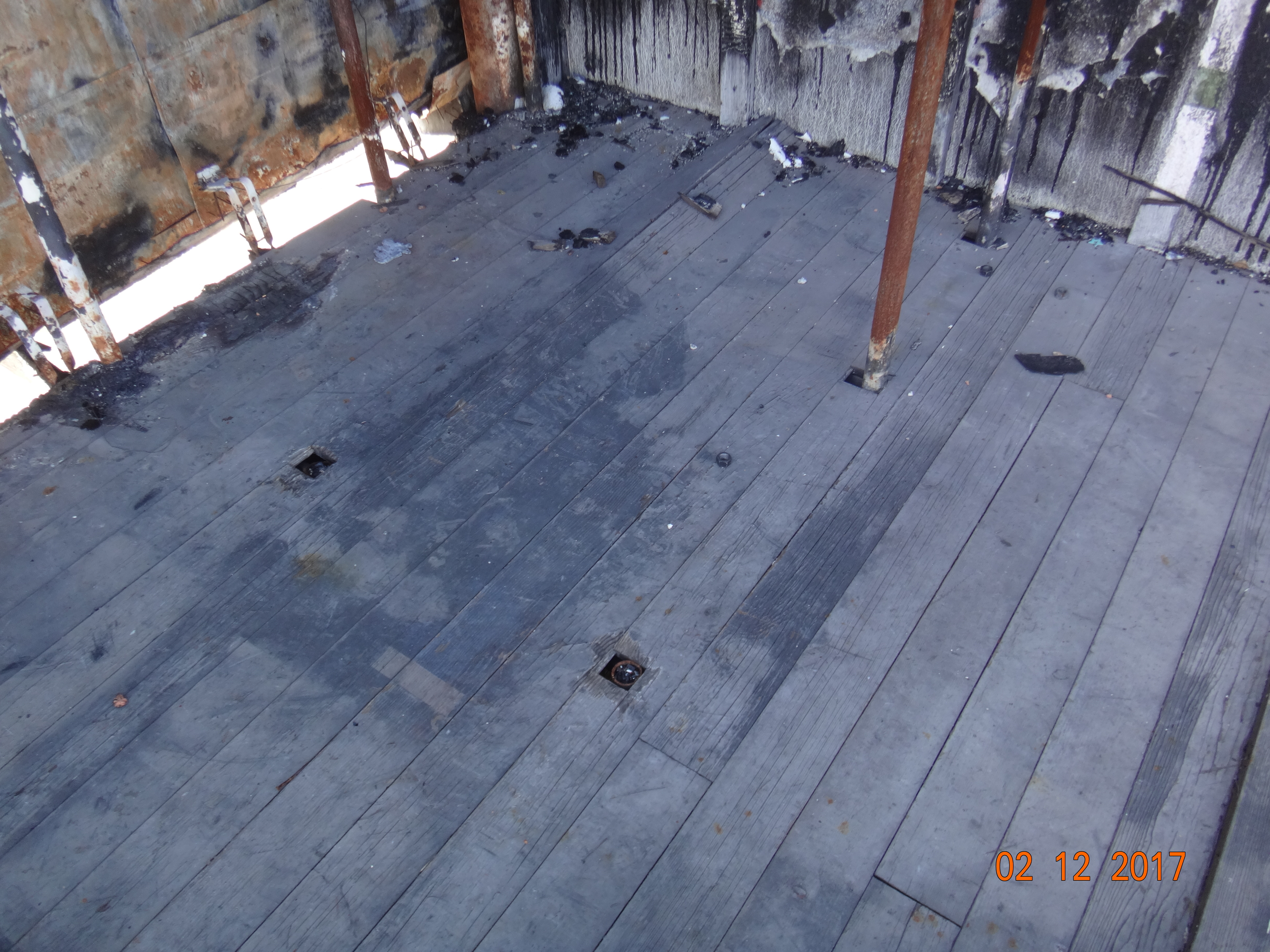The Sub Burndown
Saturday December 26, 2015
Section 1
- The Sub Fire -
Unidentified Incendiary Device (UID) #2 On Top Of The Sub Roof
Play segment from documentary above
It is our assertion that all evidence point to Unidentified Incendiary Device (UID) #2, in fact, was an incendiary device ignited on top of The Sub roof. No actual facts or reasoned deductions support a theory that it is the fire having burned through the roof!
Giving the benefit of doubt to firefighters is reasonable but in the case of UID #2, these available facts should leave no room for doubt.
- 10:46am - Fire starts.
- ≅10:50am - Voluminous white smoke and hot gases vent from open roof louver [see video].
- ≅10:57am - Three firemen on roof witness the first fire coming from open louver at end of The Sub front peaked roof [see video]. It has taken 11 minutes for the fire to reach the open venting louver.
- ≅10:58am - UID #2 goes off on The Sub roof – This is only one minute after the fire has just reached and is seen coming from the open louver at the front roof peak [see video]. It is less than 45 seconds after the firemen leave the area.
- 11:02am - UID #2 is washed down the scupper and is gone – It appears and grows to full- size in 60 seconds. It is washed down the scupper after only four minutes of burning. It takes only five seconds of water to wash it away [see video sequence].
- Front louver continues to vent both smoke and flame as before [see video].
- No part of the roof is burned through yet as evidenced by the lack of fire or smoke from the former location of UID #2 [see video].
- ≅11:15am - SLO City FD leadership has ladder truck T-1 direct its overhead stream into the louver that was venting smoke and fire from the initial incendiary [see video]. This pushes the fire back into The Sub and spreads it across the roof.
- ≅12:30pm - The Sub roof finally burns through.
- It took over 90 minutes for The Sub's front peaked roof to burn through. This is true even though it is above the primary fire, above both the initial UID in the front window box, and over the entire path the fire would follow from the original location towards the open louver at the end of the peaked roof that is venting the fire.
- The flat portion of the roof where UID #2 went off is past the peaked roof with the open louver that is venting the fire. This end of the flat roof contains the drain scupper and is beyond (and is over 5' lower than) the peaked roof portion venting the fire.
- The flat portion that the UID #2 went off on top of is in the very corner of the roof. The fire could not have been drawn to this “dead” corner past the venting louver at the end of the roof peak with any speed or force – It would have had to burn against the draft created by the open louver that was venting the fire. This would have taken considerable time
- We feel these facts and deductions firmly show that UID #2 was on top of the roof and most likely an accelerant.
TIMELINE

Section 2
- Square Deal Recordings & Supplies (SDRS) Fire -
Section 3
- San Luis Obispo City Fire Department (SLO City FD) Issues -
Above: Remains of roof in corner where UID #2 went off —
1. Most of flat roof is still unburned and in debris pile.
2. UID #2 burning on top of roof has turned the TPO roofing silver gray — only where UID 2 burned was the white TPO roofing turned silver gray which is consistent with an accelerant fire on top of the roof.
3. Plywood on burned back wall is burned and missing ONLY in location where we feel accelerant was poured onto roof.
VIDEO EVIDENCE
- Videos clearly show fire and white smoke is venting from the two open roof louvers just before UID #2 goes off [see video].
- UID #2 appears in the front corner (Side A/B of The Sub) on the flat portion of the roof. It goes from zero to full-blown in 60 seconds.
- UID #2 shows temperatures in videos that could only be achieved with an accelerant and would not be achieved if it was a fire projecting through the roof burning the wood, paper, and merchandise below [see video].
- The smoke venting from the actual fire just before UID #2 goes off is white and voluminous from the vent.
- The smoke from UID #2 is black, roiling, and sooty looking – like an accelerant.
- The parapet wall around the flat portion of The Sub's front roof is over 4' tall. So, when water is put over the parapet wall, it completely goes over the top of the fire (whether it is burning on top of or through the roof) and only has effect when it rolls back towards the roof drainage scupper. UID #2 on top of the roof is washed down the scupper drain in five seconds [see photo: The Sub roof structure] / see video: UID #2 washed down scupper].
- If the fire had burned through the roof, the water would not have washed the fire away – It would have fallen through the hole. This would not put out a large merchandise fire if it was burning underneath and it would have had no effect on a fire burning on the underside of the flat roof.
- Videos after UID #2 is out, show the fire returns to venting out the two roof louvers (and now the cut open roof hatch) and there is no sign of fire, smoke, or venting from the area UID #2 went off on top of [see video]. The Sub front peaked roof does not burn through for over an hour.
- When ladder truck T-1 started putting water into the open end roof louver that was venting the fire, a different hose was also pushing water and air in the front door. This created a positive pressure in The Sub and caused smoke to be pushed out from multiple openings in the front of The Sub, but no smoke or fire came from the former location of UID #2 – So, no hole could be in the roof or smoke would have been forced out. This means that UID #2 had to be on top of the roof not burning through [see video].
- Thermoplastic polyolefin (TPO) roofing does not melt until 1200°F. This means that non aerated wood will completely burn from underneath but, unless there is ventilation and air added to raise the temperature of the fire above 1200° F, it will not burn through the TPO roof membrane. Its normal failure mode is to tear when the roof structure collapses below it – This takes time!
- The fire took almost 12 minutes to burn across the roof to finally show venting out of the end of roof louver [see video]. (Sixteen minutes into the fire – but during the first four minutes, the fire was likely confined to the window box.) Since it took almost 12 minutes to burn unimpeded from the original seat of the fire to the vent, it would be impossible for it to have burned 8' or 10' past the vent on a lower portion of the roof (against the air flow going out the louver) then burn through ¾ 1x8, ½" plywood, 3/8" fireboard, and then through the TPO roofing in roughly the same time it took to just burn to the opening venting the fire at the end of the roof peak.
- TPO roofing discolors and turns a silver/gray when it has an immediate fire burning on top of it
- The TPO roofing left after the fire in the location of UID #2 was turned silver/gray. All other TPO roofing remained white after the fire [see TPO report and photos].
- In the photos of the debris where UID #2 went off, a large section of the original flat roof in the general area of UID #2 is seen in the debris pile fairly intact [see photo].
- The rest of the flat roof away from the front of The Sub remained after the fire. The view from underneath shows that with all the time the fire burned in The Sub, it did not burn through the flat roof. Two hours of fire does not burn 2/3 of the flat roof that remains so it would not be possible to burn through the flat roof under UID #2 in just the couple of minutes it would have had [see photo: roof section].
PHYSICAL EVIDENCE

Above: It would (and does in The Sub fire) take over an hour to burn through this type of roof located in a "dead" corner of the fire.
Actually, the fire NEVER does burn through the flat section of The Sub roof. When the front peaked roof fails around 12:30, it pulls the flat roof from the wall and leave it in the debris pile unburned.
Section 4
- Comments, Observations and Correction on Narratives by SLO City FD -
- Section 1 - The Sub Fire:
- 6 Minutes With The Arsonist
- Full Fire Investigation Never Done - Arson Investigation Refused
- Clearing The Building - Checking to Make Sure No One is Inside
- No R.I.T. or F.A.S.T. Crew Assigned
- The Sub Fire Load & Interior Details
- The Sub Roof Details
- Seven Path to Enter & Fight the Fire at The Sub
- Intentionally Assisting In Burning a Building Down is Not Firefighting
- UID #2 on Top of The Sub Roof Corner A/B
- See How the Fire Moved Through the Structures
- Section 2: Square Deal Recordings & Supplies Fire:
- The Sub Office Proves Fire Did Not Come Into The Front Of Square Deal Recordings & Supplies From The Sub Through The Firewall Between The Two Businesses
- Unknown Incendiary Device Number Three
- SDRS Fire Load Notes
- 11 Basic Stop Points for Preventing Fire Spread into SDRS from Rear
- Hole Map Illustration
- Section 3: San Luis Obispo City Fire Department (SLO City FD) Issues:
- SLOFD Fire Calls 2009-2016
- SLOFD Press Release Corrections
- Bravest Act or a Cowardly, Evil Act?
- Is BC-1 Berryman An Arsonist?
- Total Destruction is a Job Well Done
- SLOFD Fails to Follow Its Own Rules
- SLOFD Underground "Burndown" Policy
- Is SLO City FD a Corrupt Fire Department?
- How Can You Believe A Fire Department Would Help Burn A Building Rather Than Save It?
- Official CityGate Report Shows Major Fire Department Problems that City Leadership Continues to Ignore
- They Train For What They Actually Do, BURN Things Down Fast and Efficiently
- Is SLO City FD a Corrupt Fire Department?
- Letter From City Manager Derek Johnson - June 12, 2018
- Letter To City Manager Derek Johnson - July 26, 2018
- Letter From City Manager Derek Johnson - August 13, 2018
- Letter To City Manager Derek Johnson - August 17, 2018
- Letter To City Manager Derek Johnson - August 17, 2018 (#2)
- SLO City FD Actual Firefighter Strategy
- Official CityGate Report Shows Major Fire Department Problems that City Leadership Continues to Ignore
- They Train For What They Actually Do, BURN Things Down Fast and Efficiently
- Section 4: Comments, Observations, and Corrections to Narratives of SLOFD:
- SLO City Fire Department Continues to Fail Our City
- Narrative: Battalion Chief Neal Berryman
- Narrative: Deputy Chief Jeff Gater
- Narrative: Chief Garret Olson
- Narrative: Captain Michael King
- Narrative: Captain Mark Vasquez
- Narrative: Captain Matt Callahan
- Narrative: Captain Paramedic Station 3A David Marshall
- Section 5: Case Studies (Pattern of Conduct):
- Section 6: SLOFD Firefighter Narratives
- Section 7: SLOFD Fire Investigation Report
- Section 8: Arson Investigator /Expert Letters
- Section 9: Firefighting Info:
- Section 10: Original Unedited Video Material
- Section 11: Original Photographs and Images
- Cesar's Photos
- Ethan B.'s Photos
- Drones Images
- "Katie's Friend"s Photos
- Neighbor's Photos
- Jim M.'s Video
- Jimmy T.'s Video
- John I.'s Witness Videos
- KCOY Photos
- Logan C.'s Photos
- Michael H.'s Photos
- Nicole and Kjerstin's Photos
- Shar's Photos
- "PRR"'s Photos
- Sara S.'s Photos and Videos
- Final Report Videos
- Section 12: Actual Firefighting Action
- Section 13: What Real Ventilation Training Looks Like

